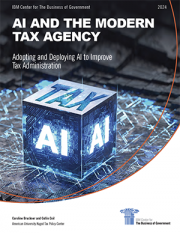
Enhancing Taxpayer Experience through AI-Aided Personalization

Blog Author: Camille Johnson, Associate Consultant, Talent Transformation, IBM
80% of tax agencies around the world are implementing leading-edge techniques to leverage data to create more efficiency and improve the taxpayer experience. This comes as the Biden Administration’s Executive Order on the Safe, Secure, and Trustworthy Development and Use of Artificial Intelligence has taken effect in the United States to ensure taxpayer privacy is prioritized. The Order has prompted AI innovation across the Internal Revenue Service (IRS) and other tax agencies.
In our most recent blog, we discussed the key indicators of success in “Streamlining Tax Operations,” which was one of our two design thinking sessions from our previous roundtable, “Adopting and Deploying AI to Improve Tax Administration.” During the “Improving the Taxpayer Experience" design thinking session, attendees focused on the importance of personalizing the taxpayer experience. For example, tax agencies face challenges of providing support to taxpayers that struggle with tax literacy, require tax education, or face unique circumstances that require tailored assistance, within a complex tax system. Al can be effectively deployed to help mitigate these challenges and increase trust among users.
Insight extraction, classification, generating education content, and translating/summarising taxpayer cases are ways in which AI has been incorporated into the building blocks for improving taxpayer experience (UX). Attendees worked through additional ideas that could be deployed in connection with a multifaceted approach, including:
- Implementing case management strategies to provide expedient, personalized support. By analyzing complex cases and taxpayer data, agencies can create targeted resolutions for investigations.
- Intelligent virtual assistants or Help Agents can assist taxpayers with instant navigation and educational support of the tax system. These agents can be integrated into various channels, such as phone, email, or chat, to offer seamless support and improve the overall taxpayer experience.
- Tax account management systems can help taxpayers maintain accurate and up-to-date information for their tax-related data. Analytics on how different taxpayers engage with the tax system can tailor advice, alerts, and reminders, ensuring taxpayer empowerment.
- Leveraging digital assistants, such as chatbots or voice assistants, for quick answers to common questions. These assistants can be integrated with natural language processing (NLP) technology to understand and respond to voice commands, making interactions more intuitive and user-friendly.
- Leveraging AI for user-friendly educational content can help taxpayers better understand tax laws and procedures. Delivery through various channels, including videos, webinars, and interactive tutorials, to accommodate different learning styles and preferences.
- Implementing anomaly detection systems to proactively identify potential errors, fraud, or missed opportunities. By leveraging machine learning algorithms and data analytics, agencies can identify patterns and anomalies that may indicate a need for assistance or further review.
- Robotic Process Automation (RPA) can automate repetitive, rules-based tasks, freeing up resources for more complex and high-value work. By automating tasks such as data entry, document processing, and compliance monitoring, tax agencies can increase efficiency, reduce the chance of human error, and enhance the overall taxpayer UX.
Statistics and quantitative indicators of success will drive the adoption of AI across tax agencies. Examples of how taxpayer UX can be gauged include:
- Usage of agency online information
- Ratio of call center successes to costs per year.
- Number of minimized refund delays on incidental errant filings
- Ratio and percents for improvement audit quality of investigations over a specific duration
Ultimately, the core of improving taxpayer UX is leveraging AI, data, and automation to deliver a personalized, supportive experience for taxpayers. IRS and global tax agency leaders are committed to developing compliance-by-design tax systems, providing early warnings of incidental errors while simultaneously providing adequate tax education, to the benefit of taxpayers.
In our final blog, Paul Dommel, Partner, Federal Tax and Finance, IBM will discuss humanizing tax with AI.



